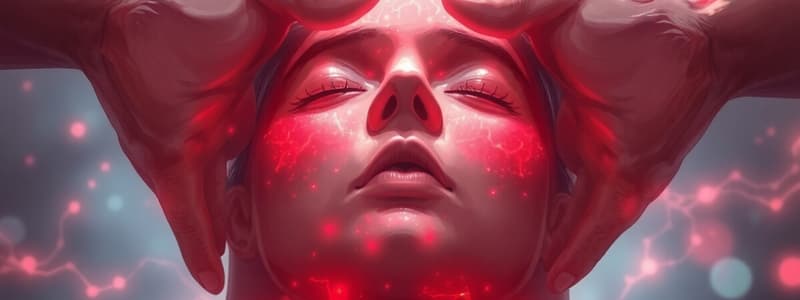Podcast
Questions and Answers
Which of the following risk factors is associated with both Squamous Cell Carcinoma and Melanoma?
Which of the following risk factors is associated with both Squamous Cell Carcinoma and Melanoma?
- Fitzpatrick Skin type 3-4
- Sun exposure (correct)
- HPV
- Chemical exposure
A patient presents with an ivory white, itchy atrophic papule with a pink rim on their labia minora. This is most likely a case of:
A patient presents with an ivory white, itchy atrophic papule with a pink rim on their labia minora. This is most likely a case of:
- Lichen sclerosus (correct)
- Vitiligo
- Acanthosis Nigricans
- Melasma
Which of the following skin conditions is often associated with insulin resistance and metabolic disorders?
Which of the following skin conditions is often associated with insulin resistance and metabolic disorders?
- Post-inflammatory hyperpigmentation
- Lichen sclerosus
- Acanthosis Nigricans (correct)
- Vitiligo
A patient presents with a large nodule that appeared suddenly and is very aggressive. This is most suggestive of:
A patient presents with a large nodule that appeared suddenly and is very aggressive. This is most suggestive of:
Which of the following is NOT a characteristic associated with venous stasis ulcers?
Which of the following is NOT a characteristic associated with venous stasis ulcers?
For a patient with a melanoma in situ (MIS) that is less than 0.8mm deep, the recommended treatment is:
For a patient with a melanoma in situ (MIS) that is less than 0.8mm deep, the recommended treatment is:
Which of the following is a common risk factor for pressure wounds?
Which of the following is a common risk factor for pressure wounds?
Which of the following is the most appropriate first-line treatment for vitiligo?
Which of the following is the most appropriate first-line treatment for vitiligo?
What type of biopsy is most commonly used for lesions above the skin surface, such as skin tags and intradermal nevi?
What type of biopsy is most commonly used for lesions above the skin surface, such as skin tags and intradermal nevi?
Which of the following treatments is typically the first line of treatment for acute urticaria?
Which of the following treatments is typically the first line of treatment for acute urticaria?
Which of the following is a common treatment option for superficial basal cell carcinoma?
Which of the following is a common treatment option for superficial basal cell carcinoma?
What is the most common cause of a Fixed Drug Eruption?
What is the most common cause of a Fixed Drug Eruption?
Which of the following is NOT a common drug associated with Stevens-Johnson Syndrome and Toxic Epidermal Necrolysis (TEN)?
Which of the following is NOT a common drug associated with Stevens-Johnson Syndrome and Toxic Epidermal Necrolysis (TEN)?
A patient presenting with grouped vesicular papules that are intensely itchy, should be evaluated for which of the following conditions?
A patient presenting with grouped vesicular papules that are intensely itchy, should be evaluated for which of the following conditions?
What autoimmune disease is Dermatitis Herpetiformis a cutaneous manifestation of?
What autoimmune disease is Dermatitis Herpetiformis a cutaneous manifestation of?
Which of the following signs is NOT associated with Pemphigus Vulgaris?
Which of the following signs is NOT associated with Pemphigus Vulgaris?
Which of the following is a characteristic of Erythema Multiforme minor?
Which of the following is a characteristic of Erythema Multiforme minor?
What is the most common subepidermal autoimmune blistering disease?
What is the most common subepidermal autoimmune blistering disease?
Which of the following is the first line treatment for mild cases of Bullous Pemphigoid?
Which of the following is the first line treatment for mild cases of Bullous Pemphigoid?
What is the most common drug reaction, frequently seen with Penicillin and Bactrim?
What is the most common drug reaction, frequently seen with Penicillin and Bactrim?
Flashcards
Urticaria
Urticaria
Skin condition characterized by erythematous wheals of varying types.
Types of Urticaria
Types of Urticaria
Includes spontaneous, cold, solar, delayed pressure, and dermographism.
Acute Urticaria duration
Acute Urticaria duration
Lasts for 6 weeks; 50% of cases are idiopathic.
Common Drug Reactions
Common Drug Reactions
Signup and view all the flashcards
Red Man Syndrome
Red Man Syndrome
Signup and view all the flashcards
Stevens-Johnson Syndrome
Stevens-Johnson Syndrome
Signup and view all the flashcards
Erythema Multiforme Major
Erythema Multiforme Major
Signup and view all the flashcards
Pemphigus Vulgaris
Pemphigus Vulgaris
Signup and view all the flashcards
Bullous Pemphigoid
Bullous Pemphigoid
Signup and view all the flashcards
Actinic Keratosis
Actinic Keratosis
Signup and view all the flashcards
Basal Cell Carcinoma (BCC)
Basal Cell Carcinoma (BCC)
Signup and view all the flashcards
Nodular BCC
Nodular BCC
Signup and view all the flashcards
Squamous Cell Carcinoma (SCC)
Squamous Cell Carcinoma (SCC)
Signup and view all the flashcards
Melanoma
Melanoma
Signup and view all the flashcards
Melasma
Melasma
Signup and view all the flashcards
Acanthosis Nigricans
Acanthosis Nigricans
Signup and view all the flashcards
Vitiligo
Vitiligo
Signup and view all the flashcards
Pressure Wounds
Pressure Wounds
Signup and view all the flashcards
Venous Stasis Ulcers
Venous Stasis Ulcers
Signup and view all the flashcards
Shave Biopsy
Shave Biopsy
Signup and view all the flashcards
Study Notes
Urticaria
- Erythematous wheals are a characteristic symptom
- Types include spontaneous, cold, solar, delayed pressure, and dermographism
- Acute urticaria lasts less than 6 weeks
- Chronic urticaria lasts more than 6 weeks
- 50% of cases are idiopathic (no identifiable cause)
- 40-50% are autoimmune, sometimes related to thyroid issues or H. Pylori
- Treatment initially involves antihistamines, and may progress to more potent medications like Dupixent, doxycycline, or cyclosporine; further testing and specialist consultation may be necessary
Common Drug Reactions
- Penicillin is a frequent culprit
- Bactrim can cause severe reactions
- Morbilliform rash/exanthem is commonly generalized on the trunk
- Symptoms typically appear 7-14 days after drug exposure
Fixed Drug Eruptions
- Characterized by round or oval patches that remain at the same location after exposure
- Frequently associated with NSAIDs, particularly naproxen
Red Man Syndrome
- Occurs due to vancomycin administration
- Macular erythema develops on the back of the neck and spreads to the trunk, face, and arms
- Pruritus (itching) and hypotension are sometimes present
- Treatment typically entails antihistamines and slowing down the infusion
Erythema Multiforme
- Minor cases are associated with HSV; no systemic symptoms, and minimal mucosal involvement
- Major cases are associated with Mycoplasma and HSV; systemic involvement and significant mucosal involvement
Stevens-Johnson Syndrome & Toxic Epidermal Necrolysis (TEN)
- Eruption typically appears 7-21 days after medication use
- Mucosal involvement and skin peeling are common
- Drugs associated with this include allopurinol, sulfa drugs, and anticonvulsants
- Severity categorized by body surface area affected; <10% for Stevens-Johnson, 10-30% both, >30% for TEN
- Prognosis impacted by prompt discontinuation of the responsible drug
- SCORTEN is a prediction tool for mortality risk
Pemphigus Vulgaris
- An autoimmune epidermal blistering disorder affecting the spinosum layer
- Diagnostic evaluation should also include blood work
Bullous Pemphigoid
- Autoimmune subdermal blistering disorder at the dermal-epidermal junction
- Commonly associated with neurological disorders, such as multiple sclerosis, stroke, bipolar disorder, dementia, and Parkinson's disease
Dermatitis Herpetiformis
- Cutaneous manifestation of celiac disease, commonly associated with HLA-DQ2 and thyroid disease
- Characterized by itchy, grouped vesicular papules
Actinic Keratosis
- Small, dry, rough, erythematous, and flaky lesions
- Often precancerous, linked to sun exposure
- Treatment options include cryotherapy or topical 5-fluorouracil (5-FU) for multiple lesions
Basal Cell Carcinoma
- Most common skin cancer, rarely metastasizing
- Increased risk with sun exposure and genetic predisposition
- Superficial BCC affects the epidermis while nodular BCC is red, raised, and scaly with telangiectasias
- Treatment options include electrodesiccation and curettage, 5-FU, or Mohs surgery for the nodular type
Squamous Cell Carcinoma
- Second most common skin cancer, particularly dangerous due to high metastasis rates
- Risk factors include sun exposure, HPV, smoking, immunocompromised status; lichen sclerosis, or chemical exposure
- Treatment depends on the stage (in situ vs. invasive) and may involve surgical excision, topical 5-FU, or Mohs surgery
Melanoma
- Most common type is superficial; follow-up exams every 3 months essential for the first two years
- Dysplastic nevi (moles) often provide clues to early diagnosis, but severity hinges on depth
- Depth of melanoma is the most important factor in prognosis/treatment, requiring wider excision
Merkel Cell Carcinoma
- Rare, aggressive skin cancer often presenting as a large nodule
- Diagnosis is typically made via biopsy
Kaposi's Sarcoma
- Rare cancer affecting blood vessels or lymphatic vessels
- Often associated with immunocompromised states or organ transplantation
Melasma
- Symmetrical hyperpigmented macular patches
- Common in women, particularly during pregnancy or oral contraceptive use
- Treatment focuses on reducing UV exposure and lightening treatments
Post-Inflammatory Hyperpigmentation
- Hyperpigmented macules/plaques that show up after injury
- Skin trauma and inflammation are frequent causes
- Typical timeframe for resolution is 6-12 months Treatment includes sunscreens and topical lightening agents (hydroquinone).
Acanthosis Nigricans
- Hyperpigmented, velvety patches, often associated with insulin resistance, obesity, and metabolic disorders
- Treatment often involves targeting underlying conditions and managing symptoms with topical retinoids or keratolytics
Vitiligo
- Depigmented macules/patches
- Linked to thyroid conditions or family history
- Treatment focuses on sunscreen and topical agents (steroids, tacrolimus, vitamin D)
Lichen Sclerosus
- Ivory white, itchy, atrophic skin papules with a pink rim
- Risk factors include autoimmune dysfunction, skin disease, family history, and thyroid history
- Commonly seen on labia minora in women
Pressure Wounds/Ulcers
- Develop due to compression or pressure on bony prominences
- Risk factors include sensory impairment, advanced age, malnutrition, and prolonged immobility
- Staging categorizes the depth of involvement (intact skin to damage impacting bone and muscle)
- Management focuses on prevention (pressure relief), and treatment (depends on stage).
Arterial Ulcers
- Ulcers have a punched-out appearance with severe pain, possibly accentuated with movement
- Diagnostic tools include ankle-brachial index (ABI) measurements, often necessitating an assessment of blood flow
Venous Ulcers
- Common vascular condition frequently occurring on the medial malleolus of the lower leg
- Associated risk factors such as smoking and diabetes play significant roles
Stasis Dermatitis
- Chronic inflammatory skin condition due to venous insufficiency; usually presents as scaly, hyperpigmented rash
- Diagnosis requires assessment of skin and history; venous ulceration is usually present
- Treatment protocols include wound care, elevation, compression therapy, and treatment of associated factors
- Treatment includes compression stockings, especially for durations exceeding three months for optimum results
Shave Biopsy and Punch Biopsy
- Shave biopsies are used for skin lesions above the skin's surface
- Punch biopsies are used for skin lesions beneath the surface skin
Studying That Suits You
Use AI to generate personalized quizzes and flashcards to suit your learning preferences.




